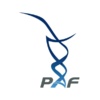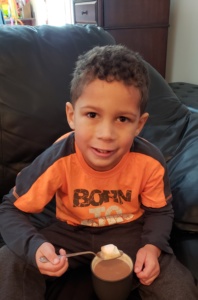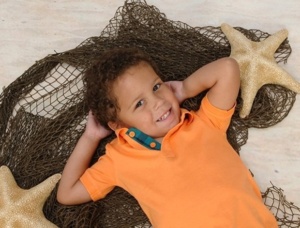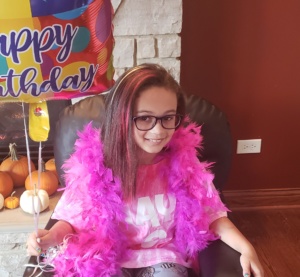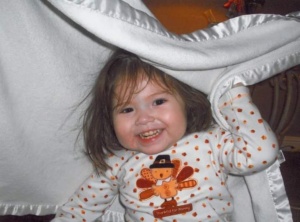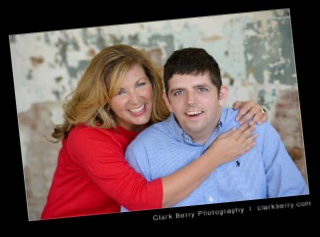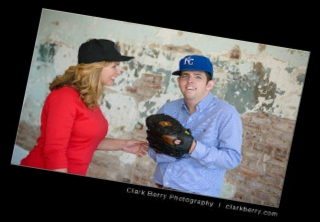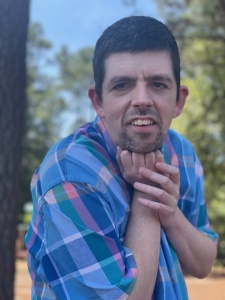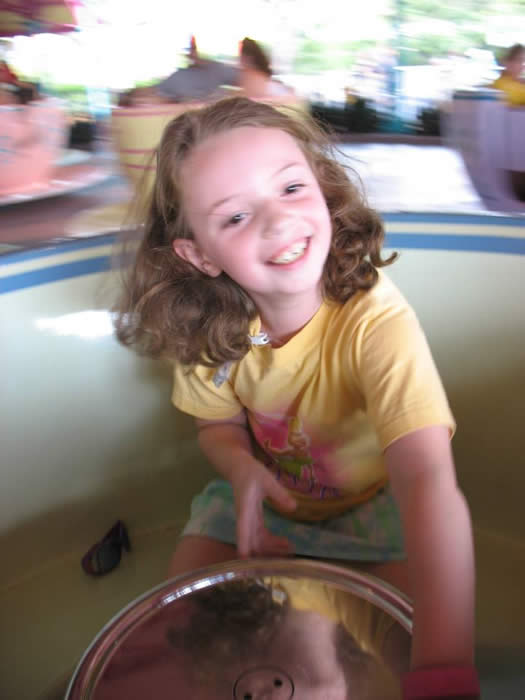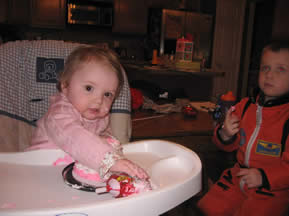Dylan J | Acidémie propionique | Age 2 1/2
Dylan J est né le Octobre 12e, 2013 à Waconia, Minnesota, pesant 8 livres sterling, 2 ounces. Après Dylan est né, les médecins remarqué qu'il avait une température corporelle inférieure à la moyenne, alors ils l'ont ramené à la crèche pour le réchauffer. Il a été ramené à nous, et à partir de là pendant deux jours, nous avons connu une normale, petit garçon en bonne santé, ou alors nous avons pensé.
Dans les premières heures du matin sur Octobre 15e, seulement 15 heures depuis que nous avions reçu leur congé de l'hôpital en tant que famille de 3, Dylan a agi un peu étrange. Il était très somnolent, et semblait froid au toucher. Mon mari, Adam, et je pris sa température et il était à 95 degrees. Sachant cela n'a pas été normale, J'ai appelé ma soeur- en- loi, qui est une infirmière USIN ici dans les villes, et elle nous a dit d'essayer de faire la peau à peau pour le réchauffer, et si cela ne fonctionne pas, appeler probablement le pédiatre sur appel. A notre grande consternation, une heure passée et il n'a pas réchauffé du tout, même après tout ce que nous avions essayé. J'ai appelé le pédiatre sur appel et il nous a dit de le surveiller au cours des prochaines heures, s'il était encore froid et était encore très léthargique et ne voulait pas manger, nous pouvions attendre de lui apporter au bureau de pédiatre qui a ouvert à 8h ce matin, ou nous pourrions l'amener à la salle d'urgence. Environ une heure plus tard, mon mari a pris Dylan jusqu'à me l'amener à essayer et aliments pour animaux, et ses bras tombèrent mollement derrière son corps. Il est une image qui est brûlé dans mon esprit. Nous savions à ce moment que quelque chose clochait, donc nous lui avons emballé dans son siège de voiture et l'a conduit à la salle d'urgence. Une fois là, ils l'ont regardé par-dessus, and told us that since babies can’t tell us what’s wrong, they would need to do many blood tests and a spinal tap to narrow down what was going on. I remember the ER doctor telling us it was hard to watch little babies get pricked so he told us to go wait in another room (little did I know I would witness far more worse that these pokes in Dylan’s life to come). Dylan’s breathing also started to become extremely labored, he was really trying hard to get each breath in and out. I don’t remember how long we were in the room, but I do remember the doctor coming and telling my husband and I, they didn’t have any results back yet, mais ils croyaient qu'il devait être transféré à l'hôpital pour enfants au centre-ville de Minneapolis, pour le mettre sur un ventilateur, parce qu'il devenait trop épuisé de travailler si dur de respirer. Il a quitté la salle, et je l'ai perdu, un ventilateur, pour mon petit bébé? Ce qui était faux? Plus tard, le médecin revint et dit, il croyait en fait, ils pourraient être en mesure d'essayer simplement de l'oxygène, de sorte qu'ils ont été le transférer à l'étage, à leur UNSI, pour voir si nous pouvions l'obtenir sous contrôle.
Il était alors, que le jeu d'attente a commencé. Ils ont fait des tests sanguins multiples, à un moment donné arrive à la conclusion qu'il était déshydraté. Son taux de sucre sanguin était très faible, et ils croyaient qu'il avait tout simplement pas assez mangé. Heures passé par, et nous attendions le néonatologiste qui a fait ses rondes autour des hôpitaux plus suburbaines, pour arriver et regarder Dylan. Autour de l'heure du déjeuner, le médecin est venu et l'a regardé et nous a dit qu'il croyait que Dylan avait encore besoin d'être transféré à l'hôpital des enfants à être mis sur un ventilateur parce que l'oxygène lui-même n'a pas été le couper. Comme il nous disait cela, une infirmière entra, lui a remis un morceau de papier, à laquelle il a regardé, répondu "oh my gosh", et quitté la salle. Nous avons été flippé, mais ne pense pas trop de celui-ci. Quelques minutes plus tard, il est revenu et nous a dit que le niveau d'ammoniac de Dylan était 900. Il regarda nos visages très confus et nous a dit que cela a été très, très sérieux, que la plage normale était 10-35, et que Dylan ne peut pas faire. Je me souviens engourdie, à l'idée que mon nouveau bébé pourrait mourir, quand une heure plus tôt, nous avions juste pensé qu'il était déshydraté. Le médecin a quitté pour mettre en place une ambulance pour prendre Dylan, pas à l'hôpital des enfants plus, mais à l'hôpital de l'Université du Minnesota Children, parce qu'il avait besoin d'un traitement spécial, disponible uniquement à l'Université. Il avait besoin d'être mis sur la dialyse.
Je suis monté dans l'ambulance avec Dylan, et ceux qui étaient le plus long 45 minutes de ma vie. Je me souviens avoir pensé qu'il allait mourir dans l'ambulance, qu'il n'y avait rien que je pouvais faire, Je viens d'avoir à s'asseoir sur le siège avant et prier. Une fois que nous sommes arrivés à l'hôpital, il était comme une scène d'un film, tous ces médecins nous fourmillaient, me disant qu'ils avaient attendu, expliquer ce qui se passait, moi avoir besoin de signer des formulaires de consentement pour commencer la dialyse. En me disant que faire la dialyse sur un 3 jour bébé était très risqué, mais quel autre choix que nous avons fait? Au moment où nous sommes arrivés à l'hôpital son ammoniac avait grimpé à 1200. My husband and I, et nos familles, ont été introduit dans la salle d'attente de la famille où nous avons attendu d'entendre mot sur Dylan. Il a été à ce moment nous avons été présentés à notre médecin métabolique. Elle est venue et nous a rencontrés et a décrit ce qu'elle croyait Dylan avait. Une maladie génétique rare, où il ne pouvait pas décomposer les protéines correctement, et au lieu de le décomposer, il ne ferait que briser un certain point, puis les mauvaises choses (propionique et de l'ammoniac), soutiendrait dans son système. Avec elle, étant aussi élevé qu'il était, il empoisonnait ses organes. Ils nous ont dit qu'ils croyaient que son cerveau était enflé et ils pourraient ne pas être sûr de ce que les dommages du cerveau qu'il avait reçu de la haute ammoniac, ils prendraient des ultrasons et une IRM, qui à la fois est sorti assez bon, mais vraiment le temps dira.
Plusieurs heures plus tard, dialyse a commencé, et une infirmière est venu, et dit les mots, Je ne pourrai jamais oublier "Je sais que cela a été le pire jour de votre vie, mais je voulais vous donner quelques bonnes nouvelles, L'ammoniac de Dylan est de 90 "! Aussi vite que il est tombé malade, il a obtenu un meilleur tout aussi rapidement. Ils ont pu précipiter les résultats de dépistage néonatal de Dylan et confirmé son diagnostic de l'acidémie propionique. Les médecins ont maintenant un diagnostic et ont été en mesure de le traiter. Au fil des jours dans l'unité de soins intensifs, son ammoniac stabilisé, ils étaient en mesure de le démarrer sur un régime alimentaire faible en protéines de Propimex et le lait maternel, et il a vraiment bien. Nous avons pu rentrer à la maison après seulement 7 jours dans l'unité de soins intensifs.
La vie avec Dylan après cela semblait aller très bien, et pour nous était "normal". Il était un bon mangeur, toujours mangé la quantité de protéines et de calories dont il a besoin pour obtenir en un jour et se développait normalement. Je voudrais vérifier ses cétones dans son urine par jour (nos médecins pensaient que j'étais un peu fou pour vérifier tant, mais il était mon indicateur que quelque chose était hors), et ils ont toujours été négatifs jusqu'à ce qu'il était sur le point 5 months old. Dylan a commencé à obtenir la trace des petites cétones dans son urine presque tous les jours. Nous essayer de pousser plus fluides, mais ils seraient encore remonter. Il mangeait toutes ses bouteilles très bien encore et d'agir tout à fait normal. Cependant, une fois que nous avons vu des cétones, nous lui apportons à la salle d'urgence et son ammoniac serait élevé, dans les 100. La partie la plus effrayante était, il n'a jamais agi différent, n'a jamais montré signe son ammoniac était élevé, sauf pour les cétones.
Après avoir été dans et hors de l'hôpital pendant des semaines à la fois entre Février et Mai, nos médecins métaboliques ont décidé de le lancer sur Carbaglu, pour aider à garder son ammoniac en échec. Lorsque nous avons été libérés de l'hôpital à la fin Avril après le début de Carbaglu, nous avons rencontré pour un rendez-vous de suivi avec nos médecins métaboliques. Il était à ce rendez-vous que le médecin de Dylan nous asseoir et nous a dit qu'elle croyait Dylan avait besoin d'une greffe du foie. Tu vois, ils ont jamais été en mesure de nous dire avec certitude si Dylan a eu un cas plus grave de PA ou non, parce que, après les tests génétiques a été fait, il est revenu que ses deux mutations avaient jamais été vu auparavant. Donc, nous sorte de dû attendre et de voir comment il a fait. Nous avons été choqués, jamais si nous avions pensé que la transplantation du foie serait quelque chose que nous discuterons pour Dylan. Mon mari et moi sommes allés la maison et pendant quelques semaines pensaient, prié à ce sujet, cria à ce sujet, fait des recherches, histoires par les autres parents qui avaient vécu cette, et finalement décidé que nous ne voulions pas attendre une autre crise qui est arrivé à Dylan et il a eu des dommages au cerveau ou pire, nous voulions Dylan à rester Dylan. Donc, en mai 8e de cette année, quand Dylan était 7 months old, nous avons placé Dylan sur la liste de transplantation pour obtenir un nouveau foie.
On July 24e, nous avons eu l'appel qu'ils avaient un nouveau foie pour Dylan. Nous avons laissé tomber ce que nous faisions et couru à l'hôpital où ils ont fait tout le travail de préparation pré-opératoire, nous a préparés, et attendu mot quant au moment où l'organe serait dans le Minnesota et lorsque la chirurgie commencerait. On July 26e, l'opération est passé. Mon mari et moi sommes allés Dylan à la salle de pré-op et l'ont remis à l'équipe de transplantation. Nous avons été guidés à la salle d'attente de la famille où nous avons attendu avec nos familles pour 8 de très longues heures. Lorsque le chirurgien est sorti, avec un sourire sur son visage, et nous a dit qu'il était allé très bien, Il était un tel soulagement. Nous avons été emmenés à l'USIP où nous avons pu voir Dylan, et aussi peur que je devais le voir, quand nous avons fait, il avait l'air si bon. Yes, il a été accroché à tant de tubes et de lignes, et il a été gonflé, mais il avait l'air tout comme notre garçon. Nous avons séjourné à l'hôpital 18 jours que Dylan récupéré. Son corps a accepté le nouveau foie très bien, et l'un des meilleurs moments de nos vies, était quand notre médecin métabolique est venu et nous a dit que les tests d'acides organiques qu'ils avaient prises sur Dylan après la chirurgie avait montré qu'il avait pas d'acide propionique dans son corps! Quel miracle.
Il a été presque 2 ans depuis Dylan a eu sa greffe et il fait fantastique. Il a eu quelques complications depuis mais il est obtenu à travers eux avec brio. Dylan sera sur la lutte contre le rejet des médicaments toute sa vie. Il y a la crainte qu'il peut aller dans le rejet à tout moment, mais si pris assez tôt, il est très traitable. Et ici, dans le Minnesota, avec nos médecins, ils garderont un œil très attentif sur lui. Nous ne disposons pas aussi beaucoup de recherches sur si le foie va durer toute sa vie, ou s'il aurait besoin d'un nouveau fini, mais en même temps, nous ne disposons pas d'une tonne de données sur ce que PA fait à long terme du corps. Nos médecins métaboliques sont en cours très prudent avec lui, ils l'ont gardé sur sa formule métabolique jusqu'à ce que cette dernière Octobre quand nous avons essayé de voir ce que ses laboratoires ont fait s'il est parti et jusqu'à présent, il est resté stable. Il est toujours sur un régime riche en protéines restreint, en ce moment il obtient 30-35g par jour. Le changement en lui depuis la greffe a été décuplé. Avant qu'il ait eu un faible tonus et maintenant son ton est tellement mieux, il court et grimpe comme tous les autres 2 ½ ans quand nous jouons au parc! Bien qu'il ait été la décision la plus difficile de mon mari et moi avons jamais fait, ce fut la bonne décision pour nous, nous voulions Dylan pour mener la meilleure vie qu'il pouvait, et même si il y avait tant de risques, et nous ne savons pas 100% ce que l'avenir nous réserve, ça valait la peine, parce qu'il est un heureux et très sain 2 ½ ans petit garçon!
